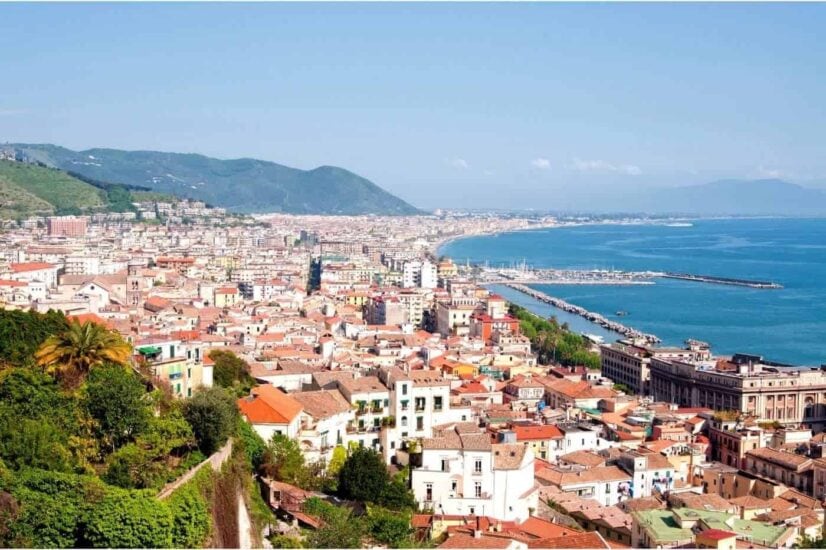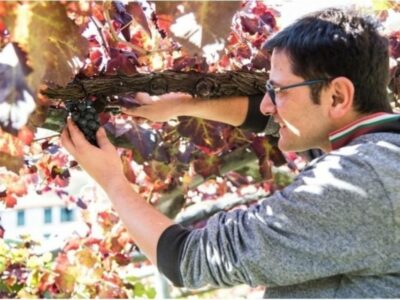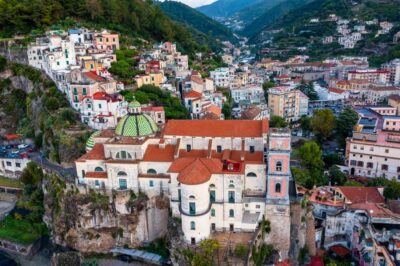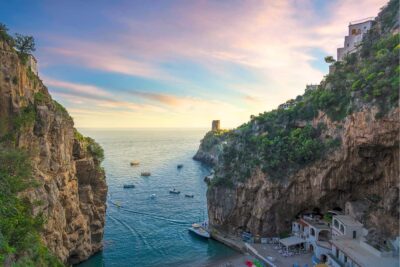Salerno is among the most beautiful cities in Campania and is strategically located right at the top of the gulf of Salerno.
In recent years it has grown a lot from a touristic perspective, attracting travellers who already come to the region to visit its many attractions.
Due to its proximity to the Amalfi Coast, Naples and Paestum, it is a strategic destination for those looking for a convenient low-budget accommodation solution.
Since it is only 40/45 minutes by ferry from Amalfi, is very close to Vietri, and offers a wide choice of clubs open until late at night, it is the ideal destination for groups or young couples, who want to discover the beauty of the Amalfi Coast and its surroundings, without giving up the allure of the more chaotic and mundane city life.
Whether you have chosen Salerno as the starting point for your trip or you simply want to spend a day there, you have come to the right place. In this guide, we will try to give you all the information you need to get the most out of the city and enjoy what it has to offer.
Indice dei contenuti
Where is Salerno?
Salerno is located between the Amalfi Coast, the Sele Plain and the Cilentana Coast, i.e. that part of the Campania coastline from the Gulf of Salerno to the Gulf of Policastro. The city has a long history, offering visitors monuments and places of great cultural fascination.
The city’s most flourishing period was during the Norman domination, when it was given the role of capital of the southern sector.
Today, the reasons for tourist attraction are different, above all the convenience in reaching this city thanks to the High Speed Railway that makes Salerno the southernmost stop of the new fast railway lines.
Transport by sea is also much improved and many cruise ships stop in the city port, allowing tourists to take a short tour.
What attracts tourists is the location, very close to the fascinating Amalfi Coast and all the main monuments of the region, but not only: the Luci d’Artista event that takes place here every year at Christmas time is also very interesting and attractive.
An enchanting moment of lights and colours that enrich the festive atmosphere in a city that is very attached to tradition. In addition to these features, however, Salerno offers several historical places, monuments, churches, culture and special customs that cannot be missed on a trip here. Let us look at them together.
Tourist itinerary: what to see in Salerno

The city’s historical centre is described as an illustrious example of mediaeval town planning where, among the monuments, the Cathedral is the most prominent.
It was founded by Robert Guiscard at the behest of Bishop Alfano I, and work began in 1080. It was then consecrated by Pope Gregory VII and officially inaugurated in March 1084.
The structure that can be seen today is that resulting from the 1688 earthquake, which led to the renovation and rebuilding of the cathedral. On the southern side of the building is the bell tower, which dates back to the 12th century and is clearly Arab-inspired.
The layout of the cathedral is articulated: a central body with three naves and a horizontal one. The novelty of the building lies in the shape of the crypt: it opens as a hall and the space is marked by columns. Here lie the remains of St Matthew.
For this reason it is also known as the Church of St Matthew. The entire cathedral has sculptural depictions of animals, starting at the entrance, which is reached after a long 18th-century staircase, where there is a lion and a lioness suckling her cub, symbolising the power and charity of the Church. The architrave has a monkey and a lion at either end: a symbol of the Church’s heresy and truth.
Walk with a view: the Castle of Arechi

If you want to have a beautiful view of the city and its Gulf, you have to go to the Arechi Castle. It is a medieval castle located 300 metres above sea level.
Traditionally, the fortress is associated with the Lombard duke Arechi II. The work of Gothic-Byzantine craftsmen dating back to the 6th century, it took on significant military importance in the 18th century when Prince Arechi II made it the city’s defence system. In 774, the prince made it the residence of the court of the Duchy of Benevento and it became the defence apex of a triangular system that encircled the entire ancient city of Salerno.
Today the castle is a fascinating location for elegant weddings, parties or conferences. In the centre of the castle is a small museum with ceramics and coins. Also very special is the medieval aqueduct, which supplied water to the convent of San Benedetto. The feature that makes it famous is the use of the ogival arch, a real innovation at the time of its construction in the 9th century.
The arch earned it the nickname of the Devil’s Bridge; today, however, one can admire its medieval arches that contrast with the modern and innovative city that has been built all around it, incorporating the history of the aqueduct.
Shopping and culture in Via dei Mercanti
The city’s most famous and characteristic street is Via dei Mercanti, which runs from the Arch of Arechi parallel to the coast. Today, as in the past, this place is the heart of shopping, accompanied by churches and ancient buildings.
Since the year 1000, in fact, this street was an important communication and trade route. In antiquity, it was called ‘Drapparia’, because along the street there were numerous shops selling textiles, a product that was traded at the time of the Lombard princely state.
Today, this street is lined with a number of small shops and establishments, as well as some important churches, such as the Church of the Santissimo Crocifisso, the Church of San Gregorio and the Church of San Giorgio.
Via dei Mercanti is also overlooked by the Pinacoteca Provinciale (Provincial Art Gallery), housed inside Palazzo Pinto, an 11th- and 12th-century noble residence. Inside the Pinacoteca is a rich repertoire of works of art ranging from the Renaissance to the post-war period and including important artists from Salerno and Campania.
The educational museum of the Scuola Medica Salernitana, inside the former Church of San Gregorio, is also worth a visit: here, you can see the codices produced in the Middle Ages by the Scuola Medica Salernitana and the famous Regimen Sanitatis Salernitanum, a treatise on medicine dated around 1050.
Proceeding along Via dei Mercanti, coming from Via Vittorio Emanuele, you also have the chance for a poetic pause, when you come across Vicolo Arco del Pinto, a small alleyway dedicated to the Salerno poet Alfonso Gatto, whose walls have been decorated with splendid fragments of poetry.
Proceeding along the whole of Via dei Mercanti, as far as Piazza Portanova, one has the chance to come across places hidden in the alleys: ideal for a break in the historical heart of the city.
Minerva’s Garden
We have already mentioned the Salerno medical school, the first medical institution in Europe with a millennial history behind it.
In this regard, we recommend a stop at the Giardino della Minerva, a botanical garden that gathers plants cultivated since antiquity on the basis of the principles of the Scuola Medica Salernitana.
In fact, the garden, now managed by the municipality, was owned by an illustrious exponent of the Salerno Medical School, Matteo Silvatico, who in the 12th century created the first example of a botanical garden in the western world, which later inspired those in Pisa, Florence, Pavia, Padua and Bologna.
The garden is laid out on various levels, connected by a 17th-century staircase leading to a beautiful pergola belvedere from which there is a view over the entire historic centre, as far as the port of Salerno.
In short, a small oasis of peace in the heart of the city.
A stroll along the Lungomare
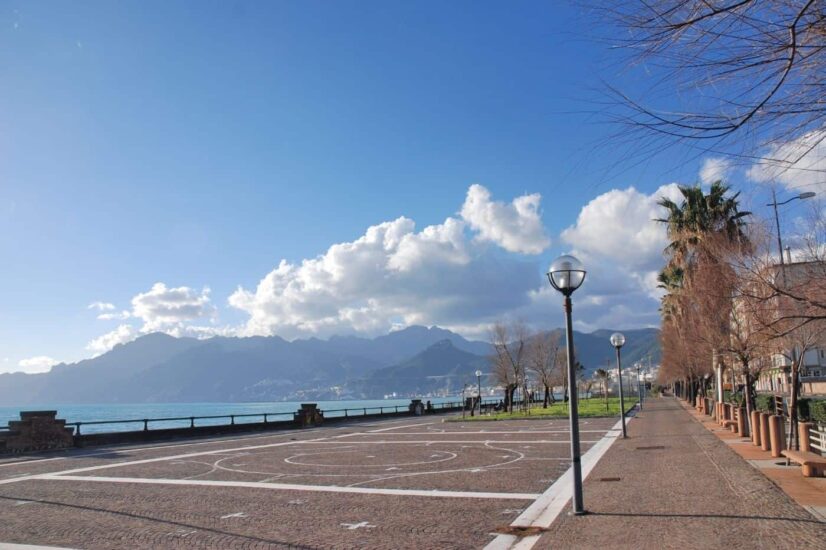
The Lungomare Trieste is a 2-kilometre-long promenade that connects the Masuccio Marina with the commercial port, next to Santa Teresa beach. It is a pleasant promenade, much used by locals and especially tourists, to move around the city.
Of particular interest to tourists is Salerno’s Maritime Station, located on the Manfredi pier of the commercial harbour, listed as a high quality architectural project in 2013.
The station was commissioned in 2000 by the mayor Vincenzo de Luca to respond to the growing demand for cruise disembarkation by various companies; thus the architect Zaha Hadid was given the task of building a modern and functional maritime station.
Today it is an ideal landing place for tourists thanks to its strategic position between the Amalfi Coast, the Cilento Coast and the islands of Capri and Ischia. The building is centred and projected towards the sea, oyster-shaped and with attractive, modern geometries.
The roof is covered with ceramic tiles, a feature that makes this tourist terminal unique. Inaugurated on 25 April 2016, it will kick off the 2016/2017 maritime season.
Also worth visiting is the Villa Comunale, which is transformed into an authentic enchanted garden during the Luci d’artista period. In summer, children and the elderly meet here to enjoy some fresh air, eating a slushy prepared by the kiosk located inside.
The last stop is undoubtedly Piazza della Libertà, very recently built and inaugurated in September 2021, after a long series of judicial vicissitudes.
Salerno and the Amalfi Coast
If you want to reach the Amalfi Coast from Salerno, or vice versa, you can use the SITA SUD buses that leave every hour from the terminus in Via Vinciprova. A convenient stop in the centre of Salerno is outside the station.
A more pleasant alternative is the Travelmar services, which depart from Molo Concordia and reach all ports on the Amalfi Coast.
If you would like more information, we recommend reading our article on travelling along the Amalfi Coast.
Salerno’s most important events
We have already mentioned ‘Luci d’artista’, the Salerno event that fills the city with coloured lights during the Christmas period. The event starts every year after the first half of November and usually ends by the first half of January. The event is made even more Christmassy by the presence of markets and side events that enliven the city.
Another very special event is the Fiera del Crocifisso Ritrovato, which is usually held in early spring and involves the entire historic centre.
The event keeps alive a tradition that dates back to the Middle Ages, when traders from all over the world flocked to the area, and brings medieval re-enactments, costumed processions, workshops and craft stalls to life along the streets of Salerno.

